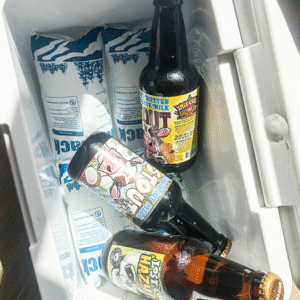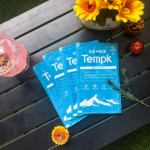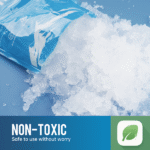كيفية حزم الجليد الجاف في مبرد بأمان (2025)
إذا كنت بحاجة إلى نتائج صلبة مجمدة, تعلُّم كيفية تعبئة الثلج الجاف في المبرد the right way is essential. ما قبل التعرّف, كتل التفاف, أضف حاجزًا, حزمة ضيقة, and vent safely. Do that and you’ll keep food frozen 24–72 hours, comply with the 2.5 kg airline limit, and avoid cracked lids or soggy messes. This guide merges and upgrades three drafts you provided into one 2025‑ready article.
-
How to pack dry ice in a cooler for 24–72 hours with a simple, repeatable method
-
How much dry ice you actually need by cooler size and trip length
-
How to pack dry ice in a cooler for flights under the 2.5 kg rule
-
How to pack dry ice in a cooler without freezing drinks using barriers and layout options
-
ماذا تشتري (كتل مقابل الكريات) and how to avoid rapid loss and food burn
How to pack dry ice in a cooler for 24–72 hours?
إجابة قصيرة: ما قبل الرغبة في البرودة, wrap dry ice blocks, add a cardboard/divider barrier, pack items tightly, والحفاظ على الحزمة تنفيس. ضع الثلج الجاف عليه قمة for the longest frozen hold (مغسلة الهواء البارد); put it under a barrier at the bottom if you want items chilled, لا تجمد. Gloves and eye protection are non‑negotiable.
لماذا يعمل من أجلك: Dry ice is –109 °F (-78.5 درجة مئوية) ويتحول مباشرة إلى الغاز (no melt water). Wrapping reduces surface loss, barriers protect liners and food, and tight packing cuts warm air pockets that “eat” your dry ice. A pre‑chilled cooler plus wrapped blocks can stretch performance from 24 up to ~72 hours depending on size, طقس, وفتحات الغطاء.
Layouts that simplify how to pack dry ice in a cooler
أعلى الحزمة (max hold): Items → حاجز من الورق المقوى → wrapped dry ice blocks → close lid
الحزمة السفلية (easy access): حاجز → wrapped dry ice → barrier → items
حزمة جانبية (منطقتين): Divider with dry ice on one side; drinks/produce on the other
| Layout Option | الأفضل ل | مراقبة | ماذا يعني لك |
|---|---|---|---|
| أعلى الحزمة | Longest frozen hold | Slightly less convenient access | Use for meat, سمكة, ice cream on multi‑day trips |
| الحزمة السفلية | Mixed “just cold” loads | Shorter frozen hold | Keeps snacks accessible; add water‑ice above barrier |
| حزمة جانبية | Split frozen/chilled | Needs a divider | Protects fillets while keeping drinks unfrozen |
Practical tips that save pounds of dry ice
-
ما قبل التعرّف: Load with sacrificial ice overnight; dump it before packing dry ice.
-
طَوّق & حاجز: Newspaper/kraft wrap every block + corrugated sheet to protect liners.
-
ملء الفجوات: Towels or frozen bottles remove air pockets and slow sublimation.
-
Shade & shut: ابتعد عن الشمس; open the lid fast and rarely.
حالة العالم الحقيقي: A 55 qt hard cooler, pre‑chilled overnight with a cardboard barrier and a 10 lb top‑pack block, kept ice cream solid for ~36 hours at 88–92 °F with minimal openings.
How to pack dry ice in a cooler: كم تحتاج?
حكم الإبهام: 5-10 رطل لكل 24 ساعة in a well‑insulated hard cooler. Scale up for larger coolers, حرارة عالية, frequent access, or flight altitude effects. Many field users plan ~10 lb per 15″ of interior length for deep‑freeze targets over 24–48 h.
مقدر سريع (use it in 30 ثوان)
-
طول الرحلة (أيام): د
-
Cooler class multiplier: Small = 1, Medium = 1.5, Large = 2, XL = 3
-
Base rate: 7.5 رطل/24 ساعة (midpoint of 5–10 lb)
-
التعديلات: +25% hot sun; +10% frequent access
صيغة: Pounds = D × 7.5 × Class × (1 + Adjustments)
مثال: 48 ح, واسطة, hot sun (+25%), frequent access (+10%) → 2 × 7.5 × 1.5 × 1.35 ≈ 30 lb.
جدول المقاسات (frozen target)
| حجم أكثر برودة | 24 ح | 48 ح | لك |
|---|---|---|---|
| صغير (20-35QT) | 5-10 رطل | 10-20 رطل | Overnight frozen snacks/meat |
| واسطة (45-65QT) | 10-15 رطل | 20-30 رطل | التخييم في عطلة نهاية الأسبوع; keep game/fish solid |
| كبير (75-10QT) | 15-25 رطل | 30-40 رطل | Multi‑day hunts or outages |
| XL (150 qt+) | 25-40 رطل | 50–80 lb | Extended runs; verify compatibility |
Estimates assume a hard, dry‑ice‑compatible cooler and tight packing.
How to pack dry ice in a cooler for flights (2025)?
إجابة مباشرة: ≤2.5 كجم (5.5 رطل) لكل راكب/حزمة, تغليف التهوية, and “Dry Ice/Carbon Dioxide, solid” marking with net weight. Seek airline approval before travel. Never tape the cooler airtight. Use gel packs to protect items when the dry ice is gone.
Checklist that passes acceptance:
-
Hard cooler that فتحات التهوية (gasket/drain cracked per maker guidance)
-
ملصق: "الجليد الجاف" (أو "ثاني أكسيد الكربون, صلب") + صافي الكتلة (على سبيل المثال, “2.5 kg or less”)
-
موافقة: Confirm with your carrier before check‑in
-
Layers: التفاف الكتل + حاجز + حزمة ضيقة; minimal air space
-
Carry/Check: Orient to vent; avoid sealed trunks during ground legs
How to pack dry ice in a cooler without freezing drinks?
حاجز + الموضع + separation. Keep drinks on one side with water‑ice; put wrapped dry ice behind a مقسم أو on top with a barrier over fragile items. That gives you cold sodas without “freezer‑burn” spots on produce or cheese.
كتلة مقابل بيليه: what should you buy?
-
كتل: أطول عقد; fewer gaps; best for 48–72 h goals
-
الكريات / شذرات: Faster pulldown; ملء الفراغات; great as a top‑up around blocks
-
“Airline cuts”: Pre‑sized packs to hit ≤ 2.5 kg when flying
Always wrap and add a barrier either way.
الجليد الجاف مقابل. حزم هلام مقابل. الجليد العادي (what’s right for you?)
| طريقة | درجة الحرارة النموذجية | Lasts About* | ماذا يعني لك |
|---|---|---|---|
| الجليد الجاف | -78.5 درجة مئوية (-109 درجة فهرنهايت) | ~18–24 h per 5–10 lb | True frozen hold; no melt water; requires PPE & تنفيس |
| حزم هلام | ≈ –18 °C to 0 °C | 12-24H (size/insulation dependent) | معالجة أكثر أمانًا; قابل لإعادة الاستخدام; great for 2–8 °C |
| الجليد العادي | 0 درجة مئوية (32 ° f) | 4-18 ساعة | رخيص, سهل; adds water weight and mess |
*Your results vary with insulation, sun, وكم مرة تفتح الغطاء.
User‑friendly safety rules you can’t skip
-
لا تقم بمنعة محكمة الإغلاق: Gas buildup can bulge lids or rupture containers.
-
تهوية المركبات والغرف: CO₂ is invisible and can displace oxygen; crack windows and avoid sealed trunks.
-
ارتداء القفازات المعزولة وحماية العين: Prevent frostbite and contact injuries.
-
Dispose in open air: Let leftover dry ice sublimate in a ventilated area—never in sinks or sealed trash.
2025 developments that change how to pack dry ice in a cooler
ما الجديد: الشاحنين القابلة لإعادة الاستخدام, بي سي إم (مواد المتغير للمرحلة) for 2–8 °C lanes, و IoT temperature loggers now complement dry ice. Teams mix لوحات VIP + PCMS to shrink dry‑ice mass, قطع النفايات, and monitor in real time. CO₂ supply dynamics still affect regional availability, so plan purchases ahead in peak seasons.
الأحدث في لمحة
-
Reusable systems rising: Less EPS waste, lower long‑term cost
-
المراقبة الذكية: App‑connected loggers flag temperature drift early
-
VIP + PCM combos: Smaller packs, درجات حرارة أكثر ثباتا, رحلات أقل
نظرة السوق: Expect steady growth in cold‑chain packaging and monitoring through the late 2020s. لك, that means more options to combine dry ice with PCMs and loggers for greener, safer trips.
التعليمات
كم من الوقت يستمر الجليد الجاف في مبرد?
In a good hard cooler, يخطط 5–10 lb for ~24 h. Heat and frequent openings shorten that; pre‑chill and tight packing extend it.
Where should dry ice go—top or bottom?
Top for frozen results (المصارف الباردة). Bottom under a barrier if you just want “cold, not frozen.”
Can I fly with dry ice in my cooler?
نعم-≤2.5 كجم (5.5 رطل) لكل راكب/حزمة, تنفيس, المسمى, and approved by the airline.
سوف يجف الثلج الكراك الخاص بي برودة?
Use a dry‑ice‑rated hard cooler and add a حاجز. Many soft coolers are لا rated.
هل الثلج الجاف آمن في السيارة؟?
Yes with تهوية. Crack windows and avoid sealed cabins during long legs.
Actionable tools
2‑minute “Do I need dry ice?” self‑check
-
Goal frozen solid ≥24 h? إذا كانت الإجابة بنعم, استخدم الثلج الجاف; if no, use PCMs/gel packs.
-
Open lid ≥1×/hr? يضيف +10% الثلج الجاف.
-
Hot sun > 90 درجة فهرنهايت? يضيف +25% dry ice and shade the cooler.
-
حمولة مختلطة? Side‑pack with a divider; مشروبات + water‑ice on the warm side.
Copy‑and‑use packing checklist (print for your lid)
-
Verify cooler is dry‑ice compatible
-
ما قبل التعرّف 12-24H
-
يخطط جنيه with the quick estimator
-
التفاف الكتل + يضيف حاجز
-
حزمة ضيقة; fill all air gaps
-
تنفيس (crack drain/lid per maker)
-
مراقبة درجات الحرارة (≤ 40 °F for food; ≤ 0 °F for frozen items)
-
التخلص منها بأمان في الهواء الطلق
حول Tempk
We help teams move temperature‑sensitive goods safely and simply. شاحناتنا القابلة لإعادة الاستخدام, حزم PCM, and connected loggers are validated to cut excursions and speed pack‑outs. تقرير العملاء fewer repacks و أطول with our standard kits. Talk to us about a dry ice or PCM setup for your lanes—we’ll turn this guide into your SOP.
























